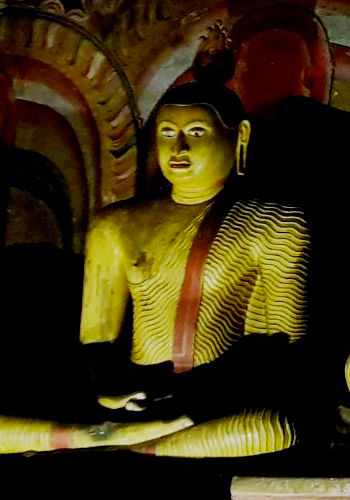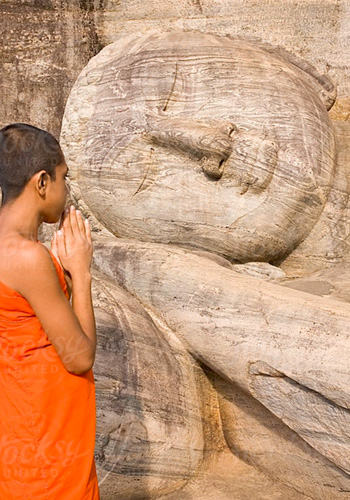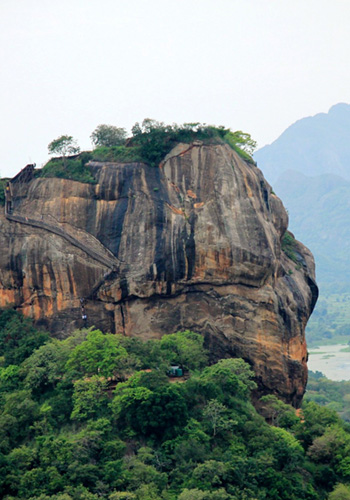
Kandy & The Cultural Triangle
Sri Lanka’s Cultural Triangle is located in the island’s centre and boasts 5 UNESCO World Heritage sites including some of the oldest cities ever recorded like Anuradhapura, Polonnaruwa, Sigiriya, Dambulla and Kandy, each with a history rooted in Buddhism. This unique part of the island belongs to the dry zone, with the exception of Kandy which is known as the Hill Capital of the island’s Tea Country. Known as ‘Rajarata’ (or King’s Land), the Cultural Triangle is almost a year round destination, making it all the more accessible, the train ride into Kandy in particular being a highlight. Temples, sculptures, ancient monasteries, forest hermitages and stupas date as far as 2000 years in some areas and are testament to the country’s early irrigation and architectural expertise. Of all these sites, Sigiriya and Kandy’s Temple of the Tooth are considered among the most iconic places of interest.
Anuradhapura
The attraction and fascination of Anuradhapura continues unabated as it plays host to several vital landmarks in the story of Buddhism in Sri Lanka, highlighted by its marvelous collection of ancient temples, monasteries, monuments, palaces, man-made water tanks and parks. From the holy Jaya Sri Maha Bodhi sacred bo-tree, to the milky white domes of the Ruwanwelisaya, Thuparamaya, Abhayagiri, Jetavanaramaya Lankarama and Mirisavetiya Stupas, Anuradhapura presents visitors with a spiritual moment of bliss that soaks into centuries of royal traditions of fervent belief. The Isurumuniya Lovers is an exquisite stone carving and the Stargate of the adjacent Ran Masu Uyana still baffles historians. A great combined visit with Anuradhapura is the nearby Mihintale where Buddhism was first introduced to Sri Lanka.
Dambulla
Dambulla is an ancient town in the Cultural Triangle best known for attractions that include the largest and best preserved cave temple complex of Sri Lanka, the Dambulla Cave Temples, the largest rose quartz mountain range in South Asia, and the Iron wood forest, or ‘Na Uyana Aranya.’ There are more than 80 documented caves in the surrounding areas of the Cave Temple, and the major attractions are spread over five caves, which contain statues and paintings depicting to the Buddha’s life. There are a total of 153 Buddha statues, three statues of Sri Lankan kings and four statues of Hindu gods Vishnu and Ganesh. The area of Dambulla is thought to have been inhabited from as early as the 7th to 3rd century BC. Statues and paintings in these caves date back to the 1st century BC. The caves of Dambulla once provided refuge to ancient kings, covered by meditating Buddhist monks. Evidence of ancient people living on agriculture has been detected in this area for over 2700 years according to archaeological findings.
Kandy
Kandy is home to the world famous Temple of the Tooth Relic. Travelers in search of a better understanding of the Buddhist faith will find themselves immersed in centuries of tradition and heritage here. Do not pass up a visit to the Peradeniya Botanical Gardens, which dates back to 1821 and during World War II was used by Lord Mountbatten, the Commander of the Allied Forces in the South Asia, as the headquarters of the South East Asia Command. Late afternoons and evenings are great for a stroll around the leafy and breezy Kandy Lake, complete with the floating Royal Garden at its center. Once a year, in July or August, the entire city comes alive as the grand Esala Perahera takes to the streets. The city resounds with the sights and sounds this pageant which is a once-in-a-lifetime experience.
Minneriya National Park
Between the high hill country of Bandarawela and the low country of Wellawaya and Hambantota, lies the small and relatively unknown Koslanda. Sitting at an elevation of 700 meters it presents a climate never too hot and never too cold, but just right. Just four hours from both Arugam Bay and Gal Oya National Park, Koslanda is among the less touristic destinations of the island’s hill country, and in colonial times was a region home to thriving tea and rubber estates. Koslanda mild climate, beautiful surroundings and remote feel make it a perfect base to unwind and explore nearby points of interest like the third highest waterfall in Sri Lanka, Diyaluma, with its enchanting cascades or the quaint hill country town of Haputale from where a visit to Lipton’s Seat is highly recommended for its sublime and enchanting views and panoramas.
Polonnaruwa
The second most ancient of Sri Lanka’s kingdoms and a UNESCO World Heritage Site, Polonnaruwa remains one of the best planned archaeological cities in the country, standing testimony to the discipline and vision of the island’s first rulers. For three centuries it was the royal capital, of both the Chola and Sinhalese kingdoms. In 1070 the Chola dynasty was overtaken by the Sinhalese King Vijayabahu I, who kept Polonnaruwa as his capital. It was during this Sinhalese period, that Polonnaruwa reached its highest glory. In the early 13th century the city’s glory was fading, it was abandoned, and the capital moved to the western side of the island, where Colombo is today. A walk through this ancient city is not complete without a stop at the king’s Audience Hall, among the best-preserved structures in the Royal Palace Group, with its beautiful stone carved elephants on the walls. Another draw for travelers is the city’s quirky and cheeky population of toque macaques. These monkey populations have been living in the ruins since human occupation and continue to thrive among the temples and religious buildings.
Sigiriya
The island’s most popular historical tourist attraction, the ruins of the ancient fortress of Sigiriya continue to welcome thousands of visitors every day of the week. Often referred to as one of the ‘eighth wonders of the world’ a visit to Sigiriya not only reveals ancient ruins and frescoes but the remnants of one of the greatest planned cities in Asia. A UNESCO listed World Heritage Site, today Sigiriya presents some of the best preserved examples of ancient urban planning, architecture, garden design, engineering, hydraulic technology, painting, sculpture and poetry; all set in a rich archaeological landscape, complemented by a fusion of symmetrical and asymmetrical elements and varying levels of axial and radial planning, that all still baffle todays’ engineers and planners. Various myths and legends entwine in presenting a shady story that links treachery and deceit, love and hate, triumph and disaster: weaving a tale of craftsmanship and sensuous art that has fascinated the masses across centuries. Sigiriya as we see it today dates back to the 5th century AD when King Kassapa I established his capital here. The complex is three kilometers from East to West and one kilometer from North to South. Existing lakes, rocks and hills were cleverly woven into the general plan, and it is best experiences early morning to avoid the crowds and the midday heat.






